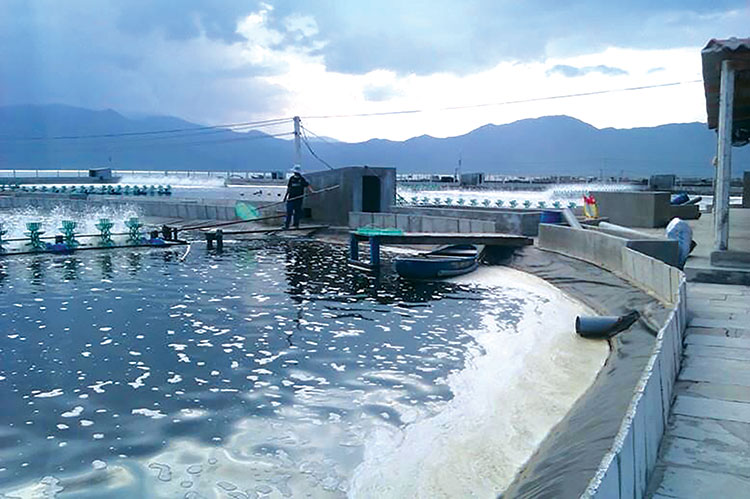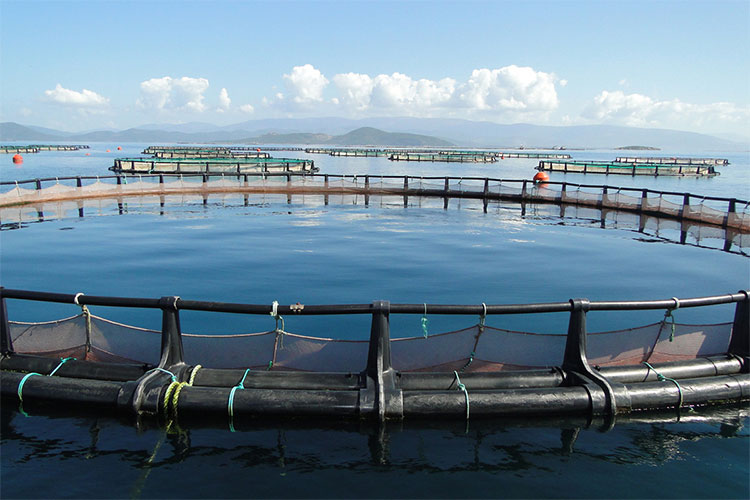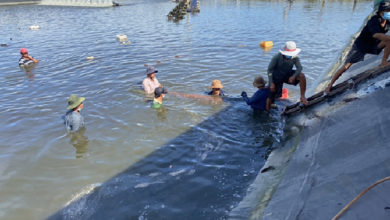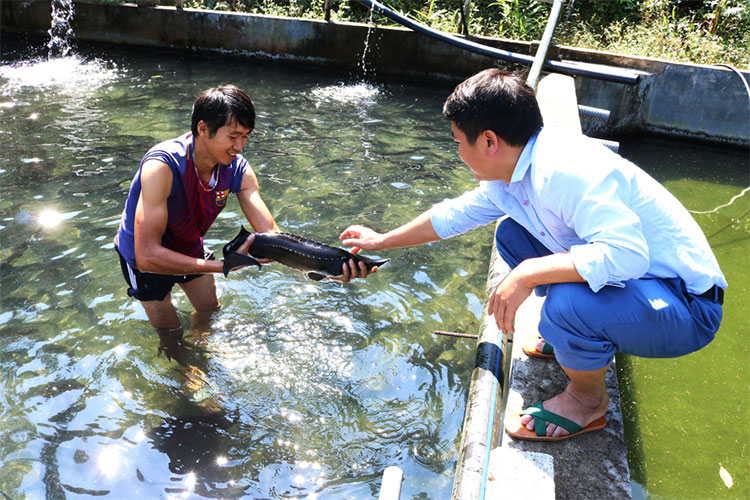Marine aquaculture: Allocating sea areas to farmers needs to be done
According to Associate Professor Dr Nguyễn Hữu Dũng, Chairman of the Vietnam Association of Marine Aquaculture, fish from marine aquaculture is valued 4-5 times more than pangasius. But up to now, there are bottlenecks for marine aquaculture industry in Vietnam.
Growing towards an industrial scale
Over 90% of aquaculture in Vietnam’s marine waters is carried out using manual methods. According to Mr. Nguyễn Hữu Dũng, there must be industrial cages to implement offshore aquaculture and organizations or individuals should be granted the right to use the sea in the long run.
Although the 2017 Fisheries Law states that the tenure for sea use in aquaculture should not exceed 30 years, no province has implemented this provision yet. Therefore, without assinging specific sea areas, farmers will continue to rely on manual aquaculture methods.
In Dũng’s opinion, a value chain must be established for farmers to participate so that they can shift to industrial aquaculture. He proposes creating models and guidelines, introducing cages made of new materials like HDPE to fishermen, providing training courses related to offshore fish farming in an industrial manner, and facilitating access to credit.
Trần Văn Phúc, Director of Bình Định provincial Department of Agriculture and Rural Development mentioned that the local goal was to change traditional marine aquaculture into an industrial scale. Additionally, the province will call for support and investment from both domestic and foreign investors to develop hi-tech marine aquaculture in Bình Định. “For now, we propose that the National Center for Promotion of Agriculture assists the province in developing offshore fish farming models using HDPE to improve economic efficiency and safety,” said Phúc.
Director of Phú Yên provincial Department of Agriculture and Rural Development Nguyễn Trọng Tùng believes that successful marine aquaculture requires economically capable enterprises, a stable market, and advanced technology. However, due to unexpected natural disasters, disease outbreaks, and fluctuating markets, policies are needed to attract business investments. According to Tùng, Phú Yên is proposing a project of aquaculture development, but financial mechanisms have remained a challenge.
Must change aquaculture technology
Dr. Võ Sĩ Tuấn, former director of the Institute of Oceanography in Nha Trang, believes that traditional sea farming methods are small-scale, unplanned, and leave negative concerns to the environment, resulting in low and unsustainable productivity. Therefore, techniques must be changed and farming technologies must be applied as a solution. Accordingly, specifications must be established so that a scheme for loans will be given and farmers and businesses will be secured.
“The connection between scientific and technological institutes and businesses is currently quite weak. We have invested in a scattered manner and lacked the application of science and technology in aquaculture,” Tuấn said, suggesting the need to build connections to address priority issues such as producing and supplying compound feed for lobsters.
Nguyễn Thị Hải Bình, CEO of STP Group, affirms that if HDPE cages are installed, integrated materials are used in advanced technology, and marine aquaculture is developed in a sustainable direction, we can build an aquaculture model in combination with tourism. This will be the model for the future.
According to Bình, there are many solutions to change traditional models into sustainable hi-tech ones. STP Group is working with the Quảng Ninh provincial authority to replace the traditional marine aquaculture with an industrial scale. Despite an investment of 5-10 times higher than old materials, the conversion is necessary because old materials are not sustainable and contribute to environmental pollution.
Sea areas must be allocated to farmers
According to Trần Đình Luân, General Director of the Department of Fisheries, there is a policy to support localities in marine aquaculture upon Decree 67. The Fisheries Law clearly specifies the procedures for assigning specific sea aseas to organisations/individuals for aquaculture within 0 – 3 nautical miles, from 3 – 6 nautical miles, and beyond 6 nautical miles. The biggest challenge lies in spatial planning beyond 6 nautical miles for large-scale business investments.
“National marine spatial planning is not something that can be done overnight. The Ministry of Natural Resources and Environment has recently brought up this issue, but it did not meet the requirements, so an extension was needed for further development. The Fisheries Law has already set standards for marine aquaculture. Standards for cages and aquaculture rafts are currently developed by the Department of Fisheries.”
As for localities, Luân emphasizes that the Fisheries Law stipulates that the district has an authority to allocate sea areas within 3 nautical miles. Without allocating coordinates, local residents will expand their cages and rafts annually. Then, local authorities feel powerless and businesses refuse to invest. Therefore, sea areas must be allocated to farmers, with clear specifications on area size and stocking density, and the establishment of cooperatives where supply chains will be established and traceability is enabled.
“We need to choose appropriate models, maybe fish farming, seaweed cultivation, and abalone – seaweed culture in combination with tourism, which is quite effective.. In Nhơn Hải (Bình Định), local residents are enthusiastic about seaweed cultivation. We also want to accompany localities. The project to switch fisheries occupations has been submitted to the Prime Minister. However, we need to calculate reasonably which occupation will bring in a better life for local residents and protect the environment better.” he added.
Nguyễn Tuấn Thanh, Permanent Chairman of Bình Định provincial People’s Committee:
A support policy is a must
Bình Định is focusing on developing its ocean economy while changing traditional cage farming into modern methods. However, Bình Định is an open coastal area, which requires significant investment and the adoption of modern and suitable aquaculture models. This makes it hard to attract business investments. Local marine aquaculture covers just about 60 hectares, most of which is conducted manually. Therefore, the local authority desires supportive policies to promote more modern farming models.
Hồ Tuấn Tú, Director of Thanh Trúc Construction Company, Quy Nhơn city, Bình Định province:
Modern marine aquaculture
I have visited the marine aquaculture model of Australis Vietnam Seafood Company in Khánh Hòa province, and I’ve seen that they are doing an excellent job by applying modern technology. Regional aquaculture planning must be stable in the long term. The allocation of sea areas to local farmers must be carried out promptly and by law. Procedures for registering farming cages, risk insurance policies, must be expedited.
Nguyễn Hoàng Anh, Chairman of Nam Mien Trung Group:
Expansion in aquaculture instead of exploitation
The state must decisively establish a comprehensive plan, involving marine planning and water area determining for aquaculture. Specific quotas must be given, allocated, and managed upon specific species. Breeding, technology application, equipment installation, production, cultivation, preservation, processing, and trading of aquaculture products must be implemented cohesively to disseminate to residents and businesses. A policy framework to attract investment into marine aquaculture should be given so as to help Vietnam truly thrive in its ocean economy.
Engineer Phạm Đức Phương, Director of the High Technology Agriculture Center, Research Institute for Aquaculture no.1, MARD:
The equipment lasts for 50 years, the permit is issued for 20 years!
Marine aquaculture facilities require a significant investment. The equipment for these farms is expensive. Their lifespan is about 50 years, yet the permits are limited to only 20 years, which results in wastage. During the storm season, farmers are forced to harvest and sell their products quickly at low prices. We can adjust the harvest time and improve the resilience to waves and storms, so that the harvest can be conducted after Tet Holiday when high prices are offered.
VFM






